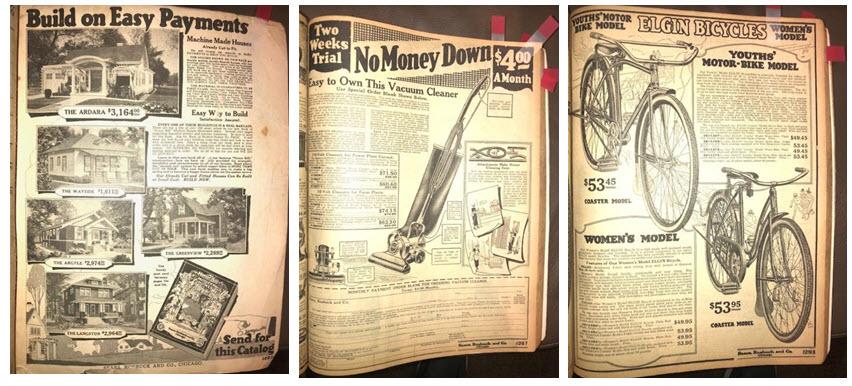100 Years Ago Today, This Was The World’s Most Disruptive Technology
Submitted by Nick Colas of DataTrek Research
The history of US consumerism starts with the Sears Roebuck mail order catalog. Yes, the very same Sears that is struggling to emerge from bankruptcy today. But 125 years ago the company was every bit the disruptive innovator. A brief summary of how that happened:
-
Mail order became viable in the late 1800s because of the expansion of the US rail system, post office regulations that allowed for catalog mailers at 1 cent/pound, and Rural Free Delivery.
-
The first Sears catalog was published in 1894 with the slogan “The Cheapest Supply House on Earth”.
-
Its target audience was rural America, which in 1900 was 60% of the US population. This was a deeply underserved community, often with just a thinly stocked general store to supply all their needs.
-
The 1903 catalog added the commitment of “Your money back if you are not satisfied”, reassuring customers that buying a product sight-unseen was a viable way to shop.
We recently bought a 1920 Sears catalog from an eBay seller. Printed in late 1919, it is a fascinating snapshot of American life 100 years ago. And, at 1,493 pages, it is a remarkably wide-angle view of that image.
In studying this early bible of the American consumer, three points struck us as particularly salient when comparing 1920 to 2019:
#1: The comparison to Amazon.
-
Our catalog was published 25 years after Sears began its mail order business; Amazon is 25 years old today.
-
The scope of the Sears offering in 1920 was every bit as vast as Amazon’s is today. The company offered everything from men’s/women’s/children’s clothing to furniture, appliances, jewelry, home entertainment, toys, and even entire houses and farm buildings.
-
Sear’s merchandising method was exactly the same as what you see on Amazon’s website. Every item for sale had a picture, description, and price. The catalog is organized by the type of product offered for sale, something akin to “If you like this item, you might also like this…”
-
One key difference: Sears offered credit on expensive items. If, for example, you wanted to buy a “New Freedom” coal/wood stove, you could pay $86.50 ($1,100 today) or make a first payment of $10 and then $7.50/month thereafter until you had paid $95.50. That’s a 7.1% annualized interest rate, in case you were wondering. Amazon, of course, takes credit cards.
Conclusion: Sears was actually a more ambitious business model than Amazon when it started. On day one, it was already selling a wide array of products – not just books. In terms of consumer offerings, Amazon now is right where Sears was in 1920. Yes, there are more SKUs on the website, but in terms of what people needed in 1920 the Sears catalog is remarkably complete.
#2: Early stage technology.
-
The new technologies in 1920 were electric-powered appliances and phonograph players. Radio was still some years off – the only items in the 1920 catalog were Morse code transceivers.
-
A 110-volt vacuum cleaner retailed for $57.50 – $68.00 ($740 – $870 today). For reference, a top-rated vacuum on Amazon goes for $70 today.
-
A hand-crank record player went for $30 (basic tabletop) to $225 (solid wood standup), or $385 – $2,900 today. A Bluetooth speaker today goes for about $20.
-
A basic bicycle sold for $53, or $680 in today’s dollars.
Our takeaway: the big difference between 1920s technology and today is how quickly prices come down as demand rises. Part of that is related to infrastructure; for example, in 1920 only 35% of American homes had electricity but by 1929 68% were wired for power. That, plus the disruption created by World War II, explains why vacuum cleaners remained expensive and adoption rates remained below 50% until the late 1940s. The rest, of course, is globalization, both in terms of supply and demand.
#3: A big idea can go a long way.
-
Our 1920 catalog is a relatively early manifestation of a business that continued to prosper and grow for another +50 years. In 1974, at the height of its powers, Sears built the tallest building in the world in Chicago to house its home office.
-
The company started opening retail stores in the 1920s, predominantly in urban areas to augment its rural business, and eventually had thousands of retail locations. It built its own brands like Craftsman tools, Kenmore appliances and DieHard automotive batteries.
-
In 1931 Sears created Allstate Insurance and by 1934 it had agents in every store. In 1981 it added broker Dean Witter and real estate company Coldwell Banker. In 1985 it created the Discover credit card. It was even an early Internet adopter, developing the Prodigy system with IBM.
The lesson here: even if Sears is now a tiny shadow of its former self, it pays to remember this company had an almost 100 year run of success. It survived and prospered through 2 world wars and the Great Depression, living long enough to benefit from the post World War II boom. All from one big idea: a mail order catalog.
Tyler Durden
Sat, 09/07/2019 – 22:00
![]()
Zero Hedge’s mission is to widen the scope of financial, economic and political information available to the professional investing public, to skeptically examine and, where necessary, attack the flaccid institution that financial journalism has become, to liberate oppressed knowledge, to provide analysis uninhibited by political constraint and to facilitate information’s unending quest for freedom. Visit https://www.zerohedge.com
